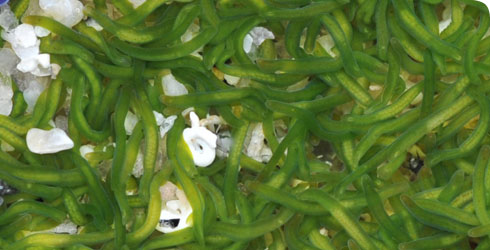Symsagittifera roscoffensis (mint-sauce worm)
Symsagittifera roscoffensis is a free-living marine acoelomorph worm. It is approximately 2–5mm long, and harbours green endosymbiotic phytoplankton (Tetraselmis convolutae) in its body cavities.
They are abundant in the summer months and are commonly referred to as mint sauce worms because of the slick of dark green they produce on sheltered sandy beaches.
Like many other acoels, this species can regenerate itself when damaged, or when a small piece is cut away, because they have a stem cell system of remarkable potency.
They are distributed in shallow waters around the Atlantic coast of Europe.
Symsagittifera roscoffensis can be cultured easily under laboratory conditions and because of this it has been used extensively to study the relationship with its endosymbionts and the biology of its stem cells.
Recent molecular evidence has shown that acoels may hold the key to understanding more fully the nature and biology of ancestral bilaterians - animals (including humans) that are bilaterally symmetrical.
All this is quite an achievement for a small beast that is considered to have one of the simplest body plans.
Species detail
This species was originally described as Convoluta roscoffensis, by Ludwig von Graff in 1891.
Symsagittifera is often found in breathtaking abundance during the warmer months. It is easily visible to the naked eye because it appears green and occurs in vast numbers.
It is 1 of less than 400 described acoel species, and is perhaps the most easily found and recognised acoel species in northern European waters.
These worms constitute a major part of the meiofauna - very small animals that live amongst coastal sand grains and sediments - albeit seasonally.
-

Taxonomy
Acoel worms may be flat, but they are not flatworms. Their position in the tree of life is uncertain, but holds vital clues to the evolution of complex animals. Read on to discover more.
-

Distribution
Symsagittifera roscoffensis is a marine worm that lives in shallow waters around the Atlantic coast of Europe. Find out more.
-

Biology
Symsagittifera roscoffensis worms have a simple body plan and depend on a photosynthetic alga for nutrition. Although the worm is born without its vital passenger, it houses up to 25,000 algal cells by the time it reaches adulthood. Find out more about this worm’s body shape and how it can repair itself.
-

Evolutionary developmental studies
Acoel worms hold a pivotal position in the animal kingdom and provide a perfect model for studying how complex animals evolved from a simple body plan. Explore some of the scientific questions this model organism is helping to answer.
-

References
Get reference material for Symsagittifera roscoffensis.
Images
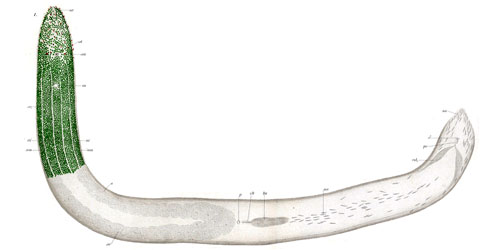
Drawing of Symsagittifera roscoffensis from Ludwig von Graff’s original description, 1891.
© Natural History Museum, London
Scanning electron microscope (SEM) image of juvenile Symsagittifera roscoffensis, ventral surface.
© Henrike Semmler and Andreas Wanninger, University of Copenhagen. Creative Commons Attribution License, Frontiers in Zoology.
Scanning electron microscope (SEM) image of adult Symsagittifera roscoffensis, ventral surface.
© Henrike Semmler and Andreas Wanninger, University of Copenhagen
Serotonergic nervous system of Symsagittifera roscoffensis.
© Henrike Semmler and Andreas Wanninger, University of Copenhagen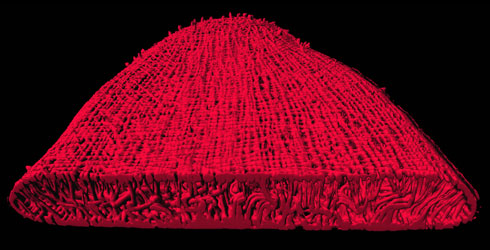
Musculature of the anterior end of Symsagittifera roscoffensis visualised with confocal laser scanning microscopy.
© Henrike Semmler and Andreas Wanninger, University of Copenhagen. Creative Commons Attribution License, Frontiers in Zoology.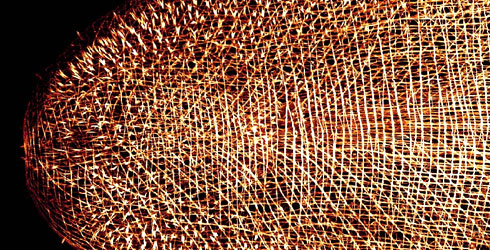
Musculature of the posterior end of Symsagittifera roscoffensis reconstructed from multiple confocal laser scanning microscopy images.
© Henrike Semmler and Andreas Wanninger, University of Copenhagen. Creative Commons Attribution License, Frontiers in Zoology.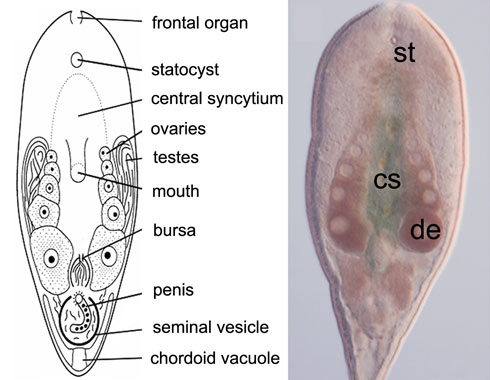
General body plan of another model acoel (Isodiametra pulchra). The photo shows statocyst (st), central syncitium (cs) and developing eggs (de).
© Peter Ladurner, University of Innsbrück. Creative Commons Attribution License, BMC Developmental Biology.About the author

Dr Tim Littlewood
Head of Life Sciences Department and Individual Merit Researcher of parasitic worms, the evolution of parasitism and metazoans.
A word from the author
"A recent study characterising the first complete mitochondrial genome of any acoelomorphs species, focussed on Symsagittifera roscoffensis (Mwinyi et al 2010). Phylogenetic analyses have proved equivocal with acoels falling either at the base of the Bilateria or grouping with the Xenoturbellida, as sister group to the Ambulacraria (echinoderms and hemichordates).
"They remain an enigmatic, problematic group of worms, but with an important role in understanding the origins and radiation of many animal phyla."
